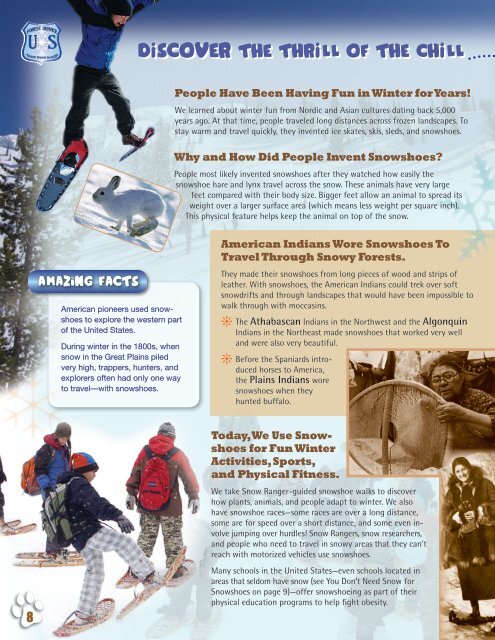The Science of Snow Meet Cutler, the Avalanche Rescue Dog ...
The Science of Snow Meet Cutler, the Avalanche Rescue Dog ...
The Science of Snow Meet Cutler, the Avalanche Rescue Dog ...
Create successful ePaper yourself
Turn your PDF publications into a flip-book with our unique Google optimized e-Paper software.
During winter in <strong>the</strong> 1800s, when<br />
snow in <strong>the</strong> Great Plains piled<br />
dvery high, trappers, hunters, and<br />
explorers <strong>of</strong>ten had only one way<br />
to travel—with snowshoes.<br />
8<br />
American pioneers used snowshoes<br />
to explore <strong>the</strong> western part<br />
<strong>of</strong> <strong>the</strong> United States.<br />
People Have Been Having Fun in Winter for Years!<br />
We learned about winter fun from Nordic and Asian cultures dating back 5,000<br />
years ago. At that time, people traveled long distances across frozen landscapes. To<br />
stay warm and travel quickly, <strong>the</strong>y invented ice skates, skis, sleds, and snowshoes.<br />
Why and How Did People Invent <strong>Snow</strong>shoes?<br />
People most likely invented snowshoes after <strong>the</strong>y watched how easily <strong>the</strong><br />
snowshoe hare and lynx travel across <strong>the</strong> snow. <strong>The</strong>se animals have very large<br />
feet compared with <strong>the</strong>ir body size. Bigger feet allow an animal to spread its<br />
weight over a larger surface area (which means less weight per square inch).<br />
This physical feature helps keep <strong>the</strong> animal on top <strong>of</strong> <strong>the</strong> snow.<br />
American Indians Wore <strong>Snow</strong>shoes To<br />
Travel Through <strong>Snow</strong>y Forests.<br />
<strong>The</strong>y made <strong>the</strong>ir snowshoes from long pieces <strong>of</strong> wood and strips <strong>of</strong><br />
lea<strong>the</strong>r. With snowshoes, <strong>the</strong> American Indians could trek over s<strong>of</strong>t<br />
snowdrifts and through landscapes that would have been impossible to<br />
walk through with moccasins.<br />
j <strong>The</strong> Athabascan Indians in <strong>the</strong> Northwest and <strong>the</strong> Algonquin<br />
Indians in <strong>the</strong> North east made snowshoes that worked very well<br />
and were also very beautiful.<br />
j Before <strong>the</strong> Spaniards introduced<br />
horses to America,<br />
<strong>the</strong> Plains Indians wore<br />
snowshoes when <strong>the</strong>y<br />
hunted buffalo.<br />
Today, We Use <strong>Snow</strong>shoes<br />
for Fun Winter<br />
Activities, Sports,<br />
and Physical Fitness.<br />
We take <strong>Snow</strong> Ranger-guided snowshoe walks to discover<br />
how plants, animals, and people adapt to winter. We also<br />
have snowshoe races—some races are over a long distance,<br />
some are for speed over a short distance, and some even involve<br />
jumping over hurdles! <strong>Snow</strong> Rangers, snow researchers,<br />
and people who need to travel in snowy areas that <strong>the</strong>y can’t<br />
reach with motorized vehicles use snowshoes.<br />
Many schools in <strong>the</strong> United States—even schools located in<br />
areas that seldom have snow (see You Don’t Need <strong>Snow</strong> for<br />
<strong>Snow</strong>shoes on page 9)—<strong>of</strong>fer snowshoeing as part <strong>of</strong> <strong>the</strong>ir<br />
physical education programs to help fight obesity.<br />
v

















